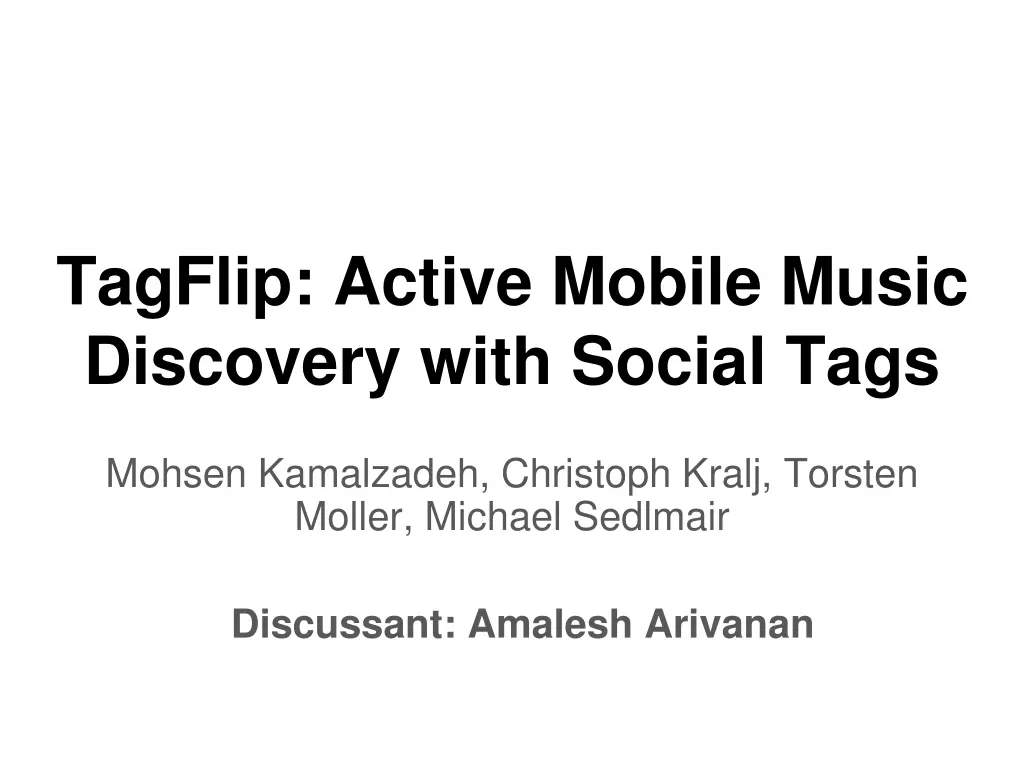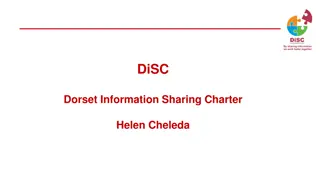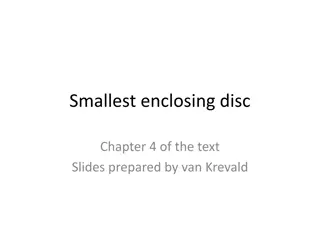
Aligning TagFlip with User Interaction Principles
Explore how TagFlip aligns with Herbert Simon's principles of bounded rationality and attention management, as well as Lucy Suchman's principles of contextual decision-making. TagFlip enhances user control in music discovery through social tags, catering to the trend of personalized content on mobile platforms.
Download Presentation

Please find below an Image/Link to download the presentation.
The content on the website is provided AS IS for your information and personal use only. It may not be sold, licensed, or shared on other websites without obtaining consent from the author. If you encounter any issues during the download, it is possible that the publisher has removed the file from their server.
You are allowed to download the files provided on this website for personal or commercial use, subject to the condition that they are used lawfully. All files are the property of their respective owners.
The content on the website is provided AS IS for your information and personal use only. It may not be sold, licensed, or shared on other websites without obtaining consent from the author.
E N D
Presentation Transcript
TagFlip: Active Mobile Music Discovery with Social Tags Mohsen Kamalzadeh, Christoph Kralj, Torsten Moller, Michael Sedlmair Discussant: Amalesh Arivanan
Relevance of TagFlip Research Today TagFlip s focus on giving users more control over music discovery remains relevant in today's push for transparency in AI-driven platforms. With the rise of personalized content across apps, TagFlip s use of social tags shows how systems can balance user input with automated recommendations. As mobile continues to dominate user interaction, TagFlip s design for small screens and real-time interaction fits the trend of on-the-go personalization.
How does TagFlip align with Simon s principles?
How does TagFlip align with Simons principles? Bounded Rationality Limitations of human decision-making capacity TagFlip fits this idea by helping users make easier choices. Instead of showing millions of songs, it narrows things down to just a few important tags to guide their decisions. Attention Management Keeping overwhelming them. TagFlip works well with this by reducing the number of actions users need to take. It directs their attention to choosing or adjusting just a few tags, instead of having them scroll through endless music options. users focused on what's important without
How does TagFlip align with Simons principles? Context-Aware Systems Adjust based on user actions and the environment to better fit real-world needs TagFlip adapts in real-time to user choices by adjusting music recommendations based on selected tags, making it fit for everyday situations like commuting or relaxing. Decision-Making and Managing Uncertainty Improving decisions step-by-step, and uncertainty refers to the unpredictability in outcomes. TagFlip allows users to gradually refine their preferences through tagging, and it helps reduce uncertainty by showing how each tag affects future recommendations, although some unpredictability remains due to the large music library.
How does TagFlip align with Suchman s principles?
How does TagFlip align with Suchmans principles? Contextual Decision-Making and Instant Feedback Actions that are performed based on the context of the moment and how systems adjust in real-time to ongoing interactions. TagFlip supports this by allowing users to modify their music preferences in real-time using social tags. The system adjusts instantly based on the user s interactions, fitting the concept of situated action by responding to the user's current music needs. Human-Machine Interaction and Attention Sensitivity How machines interact with humans while being sensitive to their limited attention span, ensuring smooth, distraction-free experiences. TagFlip aligns with this by reducing the need for excessive interactions and keeping user attention focused. The interface is designed to minimize distraction by letting recommendations with minimal effort, maintaining their attention on the task. users quickly refine music
How does TagFlip align with Suchmans principles? Challenging Conventional AI Approaches Questioning the limitations of conventional AI models, often criticizing their lack of transparency, user control, or reliance on overly rigid algorithms. TagFlip addresses this critique by moving away from black-box AI models, providing more transparency and giving users direct control over the music recommendation process through tag manipulation. It breaks the mold of traditional AI by putting the user at the center of the decision-making process. Seamless Human-Machine Collaboration Seamless interaction between humans and machines, where both work together to achieve better outcomes through a smooth exchange of inputs and responses. TagFlip fosters fluid collaboration by allowing users to interact with the system through tags, guiding the machine s recommendations based on their preferences. The system then responds by adapting to these inputs, creating a loop of collaboration between the user and the technology.
How does TagFlip impact todays projects? Bridging User Control and Simplicity: Combines user control with low effort interaction. Leveraging Social Tags: Uses social tags for personalized music recommendations. Offers clear, Transparency understandable recommendations, not a black box. in Recommendations: Adaptive Systems in Real-Time: Adjusts to user preferences in real-time on mobile devices. Focus on User Experience: Reduces decision-making stress and helps users stay focused.

















